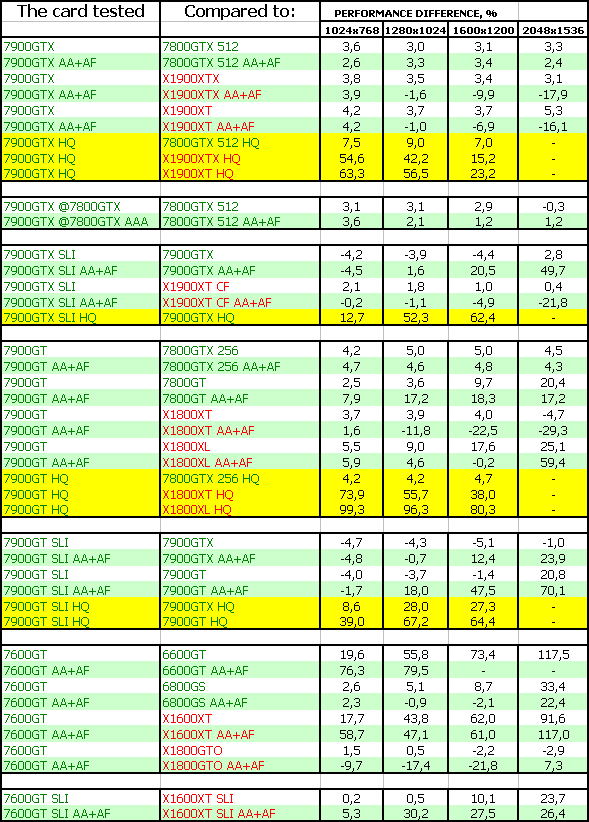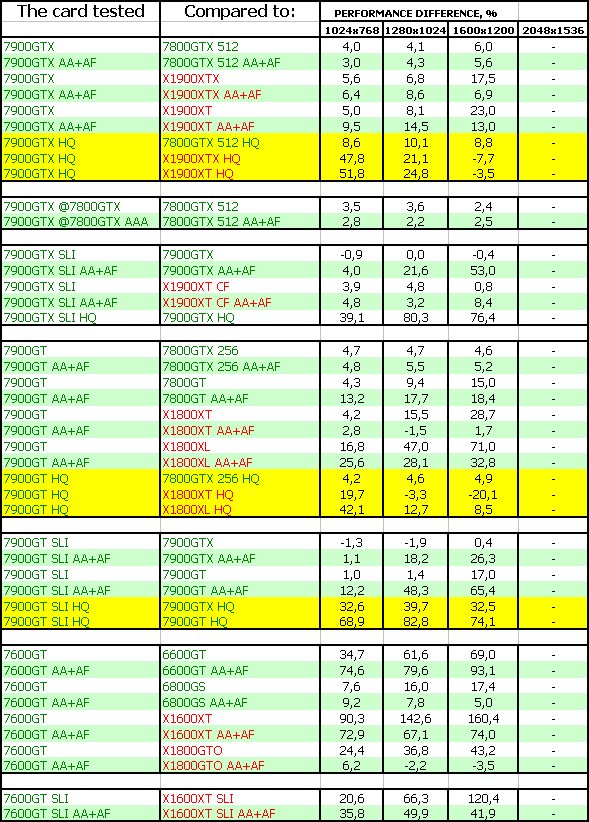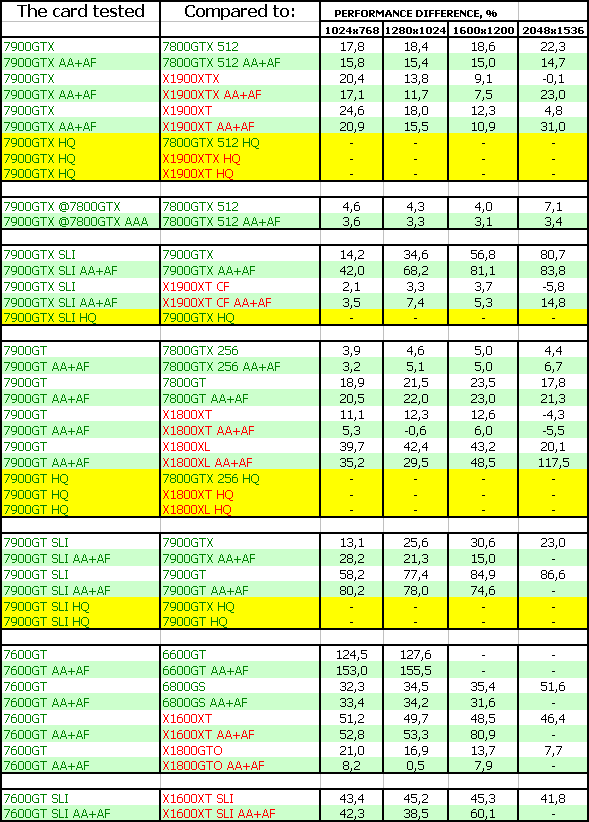 |
||
|
||
| ||
Part 3: Performance in Game Tests
The thinner and the cheaper the process technology is,
The thicker wad of money a gamer should have. TABLE OF CONTENTS
I'll remind you that many games have already reached the limits of CPU and system capacities on the whole, so we don't see the potential of top video cards even in AA 4x and AF 16x modes. That's why when we studied previous top accelerators, we introduced a new HQ (High Quality) mode. It means:
HQ:
It's the maximum that can be demonstrated by all accelerators. That is their capacity is used nearly by 100%. Even considering different implementations of AA and AF, their high quality is approximately the same.
If you think that it's impossible to compare differently implemented AA modes, I can just say that there is one criterion: maximum quality. ATI offers better AF, NVIDIA - AA. But trust me, you will see practically no quality differences, if you don't scrutinize enlarged screenshots. That's why we can actually compare both modes with a certain degree of approximation.
Test results: performance comparisonYou can look up the testbed configuration here We used the following test applications:
Considering the capacity of the latest generation of accelerators, we should analyze performance only with the AA+AF load. Otherwise, it would be a competition of processors or system units rather than video cards. Sometimes in HQ mode only. Of course, in heavy applications, where powerful video cards demonstrate mediocre performance even without AA+AF, we shall analyze these modes as well. Comparison ideology (NVIDIA - ATI): Our initial plans were the following:
But the Canadian company published an official press-release about the reduction of prices for its products:
There also appears a new product - RADEON X1800 GTO. That's just a X1800 XL card with 12 pixel pipelines instead of 16. It's price is 249USD, it falls right between X1800 XL and X1600 XT. Considering that the X1800 GTO will be launched a tad later, we ran our tests on an emulated card. So, considering the new price realia, the competition looks like this:
Game tests that heavily load vertex shaders, mixed pixel shaders 1.1 and 2.0, active multitexturing.FarCry, Research
7900 GTX demonstrates very good results in HQ mode, that's how such a card should be used. We can see good gains versus X1900 XTX. Though it does not outperform its predecessor 7800 GTX 512 that much. However, the game depends much on a processor, we all know that. We should use HDR mode already, of course, but official Patch 1.4 is still not available in Internet to use this technology on a just basis for all modern cards. Our 7900 GTX tests at the 7800 GTX 512 frequencies show that there is almost no difference. It falls within a measurement error, so the efficiency of G71 is not lower than that of G70. 7900 GTX SLI demonstrates a good gain relative to a single card, but again in HQ mode only. However, any other mode is out of the question for the fastest tandem in the world :) The 7900 GT expectedly demonstrates a tad higher results than the 7800 GTX, as both cards have the same GPU architecture and only slightly different frequencies. At the same time the 7900 GT considerably outperforms its logical predecessor - 7800 GT. But it's a tad outscored by the X1800 XT, though the X1800 XL is defeated. The 7900 GT simply enjoys the HQ mode. The 7600 GT turns out much faster than its moral predecessor - 6600GT. Not only it: even the 6800 GS with its 256bit bit and higher price is defeated. Note that the X1600 XT got a licking from the 7600 GT. The higher the resolution, the larger is the gap between them. Only the X1800 GTO, which is still more expensive than the 7600 GT, is victorious. The 7600 GT is defeated here, if we take AA+AF modes into account.
Game tests that heavily load vertex shaders, pixel shaders 2.0, active multitexturing.F.E.A.R.
In its time the game brought ATI products to leading positions. It especially concerns all GPUs with RingBus. That's why the Canadians were very good at AA+AF modes. We can see that the 7900 GTX outperforms its predecessor by 11% in regular mode and by up to 25-29% in HQ mode. The reasons for such a difference are not clear. We'll try to figure them out. What concerns competitors from the red-white camp, we can again see that the AA+AF mode does not allow the new product from NVIDIA to outperform its competitors. It's superior only in a regular mode. But there is one little victory in HQ mode. The 7900 GT is approximately in the same situation. It outscores much the X1800 XL, but the AA+AF mode puts it below the X1800 XT. However, the latter is actually more expensive. Interestingly, HQ mode reinforces the leadership of the X1800 XT. The situation with the 7600 GT is just peachy! The X1800 GTO makes the new product from NVIDIA an outsider only in AA+AF mode. But don't forget that the X1800 GTO is more expensive.
Splinter Cell Chaos Theory
As we can see, the 7900 GTX fairs rather well. It's approximately on a par with the X1900 XTX, which should remain more expensive even after price reductions. In other respects it's practically victorious. It especially concerns HQ mode. The same situation is with the 7900 GT. But there is one problem - it's outperformed by the X1800 XT in HQ mode. But let's not forget about prices, the latter is more expensive. The 7600 GT is doing great, it's only slightly outperformed by the X1800 GTO in AA+AF. But it does not matter. On the whole, the results are good.
Call Of Duty 2
Despite a good advantage over the predecessor, the 7900 GTX demonstrates rather ambiguous results versus the X1900. It's evidently defeated in AA+AF modes. And the 7900 GT is in a better situation. Even though this accelerator is outperformed by the more expensive X1800XT, its victory over the X1800 XL is impressive. In fact, the 7600 GT is doing great!
Half-Life2: ixbt01 demoTest results: Half-Life2, ixbt01 
This game has been limited by system resources for a long time, so in case of top video cards we should analyze only the HQ mode. Beyond all question, the 7900 GTX is victorious there. The same situation is with the 7900 GT. The 7600 GT is even better. So, all the three new cards are obvious leaders here.
Game tests that heavily load pixel pipelines with texturing, active operations of the stencil buffer and shader unitsDOOM III High mode
Chronicles of Riddick, demo 44

Comments are needless, I guess. While DOOM III reveals some drawbacks of NVIDIA's new products in complex modes, NVIDIA cards are doing great in CR! Especially in HQ modes! That's another brilliant proof of streamlined OpenGL operations in NVIDIA-based cards and insufficient performance in cards from the competitor (the company wouldn't write a good driver).
Synthetic tests that heavily load shader units3DMark05: MARKS
3DMark is a political product. It has little to do with game tests. No matter how hard authors try, entire ATI and NVIDIA departments are created for finetuning operations in this application to increase performance at all costs. That's why the cards can be compared in this test quite relatively. Conclusions may change polarity with the release of a new driver or a new patch to this application. Now we can see that the 7900 GTX is outperformed. But the 7900 GT fairs somewhere between the X1800 XT and the 1800 XL. Not bad for a new product, judging from prices. Like the 7600 GT, it has crashed the X1600 XT, but has been outperformed by the X1800 GTO. That's why it's very difficult to give a general assessment here.
3DMark06: SHADER 2.0 MARKS

And here all the three products from NVIDIA are successful. There is even no point in giving details. You can see everything well in the table and diagrams.
3DMark06: SHADER 3.0 MARKS

What can I say here? This test is an evident Achilles heel for NVIDIA. Indeed, it just won't work in AA+AF mode because all modern cards from NVIDIA do not support HDR+AA.
However, this test is so complex, that top video cards demonstrate very low performance even without AA+AF, so let's analyze it without AA+AF. Everything is crystal clear here: GeForce 7900 GTX wins parity with the X1900 XTX/XT; in other cases the products from the new NVIDIA series are victorious.
ConclusionsNVIDIA GeForce 7900 GTX 512MB PCI-E is no brilliant leader in performance. It has its victories, but it's sometimes defeated as well. Everything will be up to its prices. If they are really lower than those for the X1900 XTX and X1900 XT, the 7900 GTX will be successful. Besides, this product enjoys low power consumption and heat dissipation as well as an absolutely noiseless cooler. It didn't escape from the drawback of all NVIDIA cards - HDR and AA incompatibility. But it's not clear so far how much it will affect the impression produced by these cards. There is one more drawback, which also pertains to all modern products from NVIDIA - lower image quality by driver's default compared to competing cards. Our constant editor of the quality section Danil Gridasov mentioned it many times in his articles. Let's hope it will be fixed in drivers. We repeat that you don't need a master card to set up SLI. You just have to buy two cards. It's an obvious advantage over ATI CrossFire. On the whole, we have a nice impression of this card, despite all those flaws we mentioned above. Assemblage and 2D image quality is up to the mark. These are no empty words. None of NVIDIA or ATI partners traditionally manufactures HI-End products on its own, so these very cards (reference) will be sold in retail under this or that brand. We can assume that this product is cheaper than the competing model. That's why NVIDIA has a reserve for dropping the price, if necessary. The price cost of the GPU is especially low. So if the company designs a card with two such processors (which has been actually done already), the prime cost will not rise too high. But speaking of prime costs, we shouldn't forget that the real price for the X1900 XTX is dropping. Even now (early March) these cards can be found in the USA for $510-$550! I doubt that the 7900 GTX will appear at this price even there. It should be taken into account. Of course, our market realia are sky-high prices for top products, so there will be approximate parity. There remains a question: what card will be more efficient in games with heavy load on shader computations. It's very likely that the X1900 XTX may become an ultimate leader. As for now, both companies are telling us that only their approach is the only correct and promising one. We'll see. But I have a personal impression that the truth is somewhere in between: there will be games to favour RADEON and games with traditionally heavy texturing, which will set GeForce to advantage. NVIDIA GeForce 7900 GT 256MB PCI-E is a very promising product! First of all, it's based on the sterling G71 core. Its overclocking showed a very high potential of this card. Secondly, the prime cost of this card is not too high, it's even lower than for GeForce 7800 GT. That's also a reserve for possible price drops. In fact, the Canadian company will pay way too much to drop prices for its very expensive cards compared to NVIDIA. And now we can see that the 7900 GT competes very well with the X1800 XL. Sometimes it's even on a par with the X1800 XT, which will be more expensive even after a price drop. That's why this card also produces a good impression. Assemblage and 2D image quality is up to the mark. I don't know whether NVIDIA partners will start manufacturing such cards on their own from the very beginning or they'll just pack the reference cards into their brand boxes (on the first stage). The second option is quite possible. In this case the quality of reference cards is very important. NVIDIA GeForce 7600 GT 256MB PCI-E is the most interesting product among the new cards. According to our tests, this card knocks down all its competitors due to its simple design, low prime cost, and low heat dissipation. OK, this product is opposed by the formidable X1800 GTO. It's really menacing, as it possesses all R520 advantages. But firstly, the X1800 GTO will be based on the X1800 XL, which is very expensive. So I doubt very much that its initial price will be low, while the 7600 GT has a high price reduction potential. Secondly, the X1800 GTO will consume much more power than the 7600 GT, which is also important. Thirdly, R520 is discontinued. The X1800 GTO will use chips and cards from the stores. Thus their numbers are limited. And it should be noted that the X1800 GTO price is higher, even initially. But we are not going to give the palm right away. That's because we have reviewed just an emulation of the X1800 GTO in this article (based on the X1800 XL). We shall soon examine the real X1800 GTO card. Only then we'll get a true picture. Competition between the 7600 GT and X1600 XT has evidently ended in an utter defeat of the latter. Besides, the latter card is actually manufactured to oppose the 6600 GT, and it copes well with the task. But to protect the X1600 XT, the Canadian company drops its prices and brings it into another price segment. That's a smart move :) And so the main competitor to the 7600 GT is the X1800 GTO. Part IV of this article will be devoted to the account of Alexander Vorobiev's visit to NVIDIA Editor's Day. Part V of our material (it will be published in a couple of days) will touch upon video features of the new cards from NVIDIA (H.264), taking into account new decoders. So the final conclusions on these cards will be drawn in that very part. That particularly concerns the GeForce 7600 GT, as one of its key features is hardware decoding of high definition video, which is very important for a video card in this price segment. As for now, we can only say that NVIDIA has launched very interesting products, which can be really popular on the market, especially considering their low prices (we haven't seen for a long time a Hi-End card for $499 instead of $649; the junior model of this series comes at $299 instead of $399, as usual). Yep, in fact these are 6600-7800 chips converted to the new process technology. But the frequencies, architectural changes, and bundles (as well as prices) are well thought-out! But these are proclaimed prices. They may be different in reality. As always, we speak about prices at the end. Yep, about prices. All the conclusions above have been made on the assumption that the prices will be as promised by NVIDIA and ATI, judging by the recommended prices (I stress it!). As a matter of fact, everything may be different. That's especially true for our market. Thus it should be crystal clear to you that if the X1900 XTX happens to be cheaper than the 7900 GTX, you should buy it without any doubts (this situation may just as well be true, because the price for X1900 XTX is constantly dropping and will become 90% as low as the initial prices for the 7900 GTX)! And vice versa. And of course, you should take into account religious views of some market participants. For example, some people will never buy a RADEON, no matter how strong it is (my friend Sergey Sitnikov AKA Rivaboy is sure to flush with pleasure and nod in agreement :-) ). And on the contrary, no matter how good NVIDIA cards are, Andrey Karpenko AKA AndreyKAA, for example, will buy only a RADEON). But they are some of the deepest-dyed fans. The majority of potential buyers (99%) will consider the prices and features. I hope we provided you with sufficiently detailed information. It will be supplemented in Part V. Stay with us.
NVIDIA GeForce 7900 GTX/GT (G71), GeForce 7600 GT (G73). Part 4: NVIDIA Editor's DayYou can find more detailed comparisons of various video cards in our 3Digest.
Theoretical materials and reviews of video cards, which concern functional properties of the GPU ATI RADEON X1xxx (R520/580/RV5xx) and NVIDIA GeForce 7xxx (G7x)
Write a comment below. No registration needed!
|
Platform · Video · Multimedia · Mobile · Other || About us & Privacy policy · Twitter · Facebook Copyright © Byrds Research & Publishing, Ltd., 1997–2011. All rights reserved. |